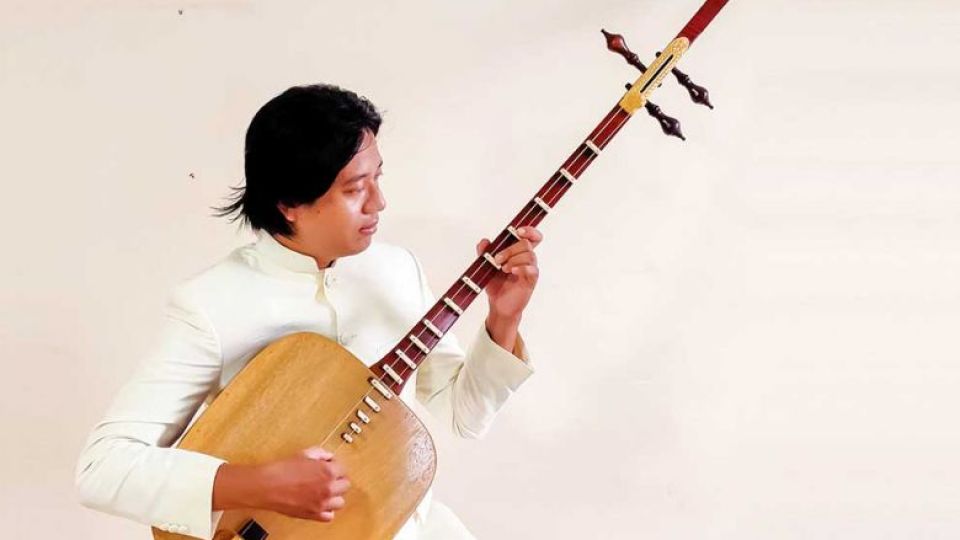July 19, 2022
PHNOM PENH – Musician Keat Sokim adapted nine classical Khmer musical instruments – tro so, tro ou, tro khser bei, chapei dong veng, ta khe, khim, khloy, rorneat ek and phin to western melodies and created the first Khmer music textbooks. He hopes that musicians will develop the books and evolve them for the next generation.
Born in Kampong Cham province and principal of the Friend Music School, Sokim said that the use of Khmer melodies combined with those from the west was not totally new, as musicians in the 60s were known for blending the two and producing symphonies.
“But we are the first group outside of state institutions that has used foreign melodies to prepare books that will teach students Khmer classical music. We are developing a traditional music curriculum with new teaching methods to help encourage today’s students,” he added.
Sokim graduated from the Phnom Penh International University in 2009 with a bachelor’s degree in English and started studying guitar at the Sokrowar Modern Music School in 2010. Early in 2012, he began classical guitar lessons at the Music Arts School with guitarists Chan Ty and Chan Kiri.
Later that year, he enrolled in chapei dong veng classes with Pich Sarath at Cambodia Living Arts and learned the twin instruments of ta khe from teacher Sak Bophavann at Wat Sansom Kosal. Sour Vanna at Arey Ksat and Yun Vanna at Neakvoan Pagoda added to his ta khe skills.
From 2013 to 2018, he also volunteered with the Community of Living Chabei. In 2018 the Friend Music School was established, and he began to come up with ways to make it easier for students to learn to play Khmer traditional instruments.
“At that time, I introduced a new method of tightening the sound of the chapei for beginners who are practicing. This method helped the students to capture the sounds quickly, saving them study time. It also meant they could easily perform together, or play alongside both traditional and modern instruments,” he said.
In 2017, Sokim participated in a cultural exchange program called Ethno Germany, introducing the chapei dong veng to musicians from other countries. In 2019, he co-directed Ethno Cambodia for the first time in the Kingdom, with international musicians joining him in Siem Reap.
The creation of western tuning for Khmer classical instruments differs according to the instrument.
“I work with a music teacher to compose the music, using western melodies for these nine instruments. It takes me more than a year to compose most of the symphonies, and up to three for some instruments. Because we have few staff and limited resources and budget, it takes us a long time. Nonetheless we are continuing to compile them,” he said.
“The textbooks take even longer because our music department still lacks many lesson materials, including the theory of Khmer music. I learned to play all of the instruments and then used the music theory that I learned from the classical guitar to explore the range of each of the Khmer instruments,” he added.
Sokim says that these melodies and textbooks enable learners of music to easily understand each song and technique in detail. Their creation serves three purposes, he added.
The first purpose is to make it easy for students to learn classical music from the very first steps, such as knowing notes, counting rhythms and music theory.
The second is to maintain the consistency of lessons. If a teacher is changed or replaced, the next will just follow the textbook.
Third, their accessibility means students can use them to teach people what they have learned, and even established teachers will see clearer progress in their students, making it more likely that they will continue to study. Both outcomes will lead to an increase in the number of classical musicians in the Kingdom.
They also strengthen assessment for university students and would have a strong role to play in the compilation and preservation of Khmer classical music. Using this helpful resource, music teachers will be able to develop and fine-tune lessons for the next generation of students.
“These textbooks will become an essential resource in advertising Khmer classical music, not only here in the Kingdom but also outside. This will raise awareness of our music, and might even attract musical experts to come to conduct research here,” said Sokim.
“They will understand that Cambodia is a country full of precious cultural arts. In the past, students from Japan, China, Bangladesh and France came to learn Khmer classical music in our schools. This helps us to see the clear importance of compiling these classical musical textbooks,” he added.


